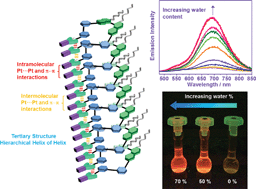Hierarchical helices of helices directed by Pt⋯Pt and π–π stacking interactions: reciprocal association of multiple helices of dinuclear alkynylplatinum(ii) complex with luminescence enhancement behavior†
Abstract
A dinuclear alkynylplatinum(II) terpyridine complex containing an amphiphilic binaphthol bridge was designed and synthesized, and was shown to display cylindrical columnar assemblies in aqueous acetonitrile solutions, presumably mediated by the Pt⋯Pt and π–π stacking interactions. The length of the binaphthol bridge was found to have a profound effect on the degree of helicity for hierarchical helices of helices and serves as a critical determinant in the formation of tertiary structures for foldamers. Interestingly, the reciprocal association of multiple helices has led to luminescence enhancement behavior, which provides a luminescence turn-on switch for the reporting of the hierarchical assembly of foldamers into higher-order structures, distinct from that of the pure organic systems. Such a transverse aggregation of multiple helices driven by metallophilic interactions has been studied by electronic absorption, circular dichroism, emission spectroscopy and electron microscopy.


 Please wait while we load your content...
Please wait while we load your content...